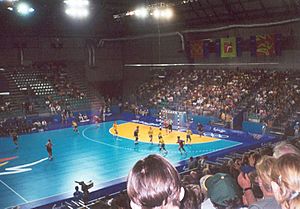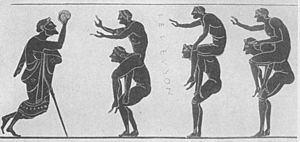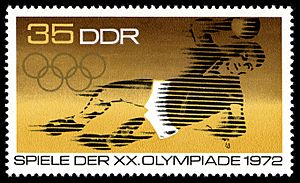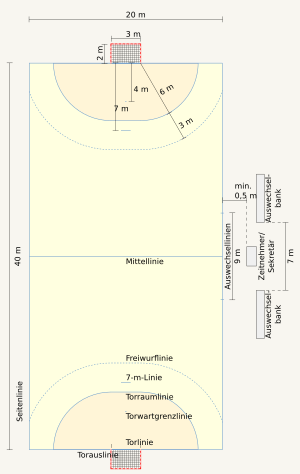Handball facts for kids
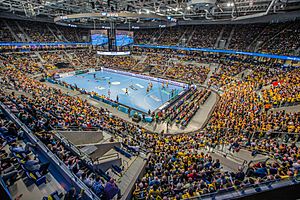
|
|
| Highest governing body | IHF |
|---|---|
| First played | 2 December 1917 in Berlin, Germany. |
| Registered players | > 27 million (2016) |
| Characteristics | |
| Contact | Limited |
| Team members | 7 per side (including goalkeeper) |
| Mixed-sex | separate competitions |
| Type | Team sport, ball sport |
| Equipment | Ball and goals |
| Venue | Indoor court |
| Presence | |
| Country or region | Worldwide (most popular in Europe) |
| Olympic | Part of Summer Olympic programme in 1936. Demonstrated at the 1952 Summer Olympics. Returned to the Summer Olympic programme in 1972. |
| World Games | Beach handball: 2001 – present (invitational sport before 2013) |
Handball is an exciting team sport where two teams try to score goals. It's a bit like soccer, but you use your hands instead of your feet! Each team has 7 players: six players on the field and one goalkeeper. Players pass and bounce a ball, aiming to throw it into the other team's goal.
A handball game lasts for one hour. It's split into two 30-minute halves, with a 15-minute break in the middle. The playing court is similar in size to a basketball court, about 40 meters long and 20 meters wide. There's a special six-meter line near each goal. Only the goalie is allowed to stand inside this area with the ball. If another player enters this zone while holding the ball, it's a foul. This can lead to a player being sent off the court for a short time or even for the rest of the game.
Contents
The History of Handball
Games similar to handball have been played for a very long time! People in Ancient Greece played ball games where they threw the ball to each other. These games were a way to get exercise and have fun together. There's even evidence that Roman women played a version called expulsim ludere.
Handball-like games were also played in medieval France and by the Inuit people in Greenland. In the 1800s, similar games existed in different countries. For example, håndbold was played in Denmark, házená in the Czech Republic, and torball in Germany.
The modern game of handball, as we know it today, started in northern Europe in the late 1800s. Countries like Denmark, Germany, Norway, and Sweden helped create the rules. The first written rules were published in 1906 by a Danish teacher named Holger Nielsen. The rules we mostly use now were put together in 1917 by Max Heiser, Karl Schelenz, and Erich Konigh in Berlin, Germany. That's why October 29, 1917, is often called the "birthday" of the sport!
The very first official handball match was played in Berlin on December 2, 1917. Later, Karl Schelenz improved the rules even more. The first international games were played using these rules. Men's teams from Germany and Austria played in 1925. Women's teams from Germany and Austria played in 1930.
In 1928, the International Amateur Handball Federation was formed. Later, in 1946, the International Handball Federation (IHF) was created. This organization helps manage handball around the world.
Handball was first played at the 1936 Summer Olympics in Berlin. After that, indoor handball became very popular in Scandinavian countries. The sport returned to the Summer Olympics in 1972 in Munich. Women's team handball was added at the 1976 Summer Olympics in Montreal. Today, the IHF organizes world championships for men and women every two years. Millions of people play handball all over the world!
How to Play Handball
The rules of handball are set by the International Handball Federation (IHF). Here's a simple look at how the game works:
Basic Rules
The handball court looks a bit like an indoor football field. Two teams of seven players (six field players and one goalkeeper) try to score goals. Here are some important rules for handling the ball:
- Once you catch the ball, you can only hold it for three seconds. You must then pass, dribble, or shoot.
- You can take up to three steps without dribbling after catching the ball.
- If you dribble the ball (like in basketball), you can take three more steps after you stop dribbling.
- After you stop dribbling, you have three seconds to pass or shoot. You can take three more steps during this time.
- Only the defending goalkeeper is allowed inside the six-meter goal area. Other players can jump into this area to shoot, but they must release the ball before landing.
The Playing Field
A handball court is 40 meters long and 20 meters wide. There's a goal at each end. Around each goal is a special area called the "zone" or "crease." This zone is marked by a line six meters from the goal. There's also a dashed line nine meters from the goal, which is the free-throw line.
Goals
Each goal is 3 meters wide and 2 meters high. They are securely attached to the floor or wall. The goal posts and the top bar are usually made of wood or aluminum. They are painted in two bright, contrasting colors so they are easy to see. Each goal must also have a net to catch the ball.
Goal Area
The goal area, or crease, is the space around the goal. It's marked by a line that is six meters from the goal. Only the defending goalkeeper can be inside this area. Field players can jump over the line to shoot the ball, but they must release it before they land inside the zone. If a player steps into the goal area to get an advantage, their team loses the ball.
Substitution Area
On one side of the court, there are special areas for each team called substitution areas. This is where team officials, substitute players, and players who have been temporarily suspended wait. Players must enter and leave the game through a specific line in this area.
Game Length
For players aged 16 and older, a standard handball match has two 30-minute periods. There's a 10-minute break at halftime. Teams switch sides of the court after the break.
For younger players, the game times are shorter:
- Ages 12 to 16: two 25-minute periods.
- Ages 8 to 12: two 20-minute periods.
If a game needs a winner (like in a tournament) and it ends in a tie, there can be extra time. This usually means two more periods of 5 minutes each. If it's still a tie, the winner is decided by a penalty shootout.
Referees can call a "timeout" during the game. This might happen if a player gets hurt, if there's a suspension, or if the court needs cleaning. Each team can also call one "team timeout" per period. This timeout lasts for one minute and can only be called by the team that has the ball.
Images for kids
See also
 In Spanish: Balonmano para niños
In Spanish: Balonmano para niños


